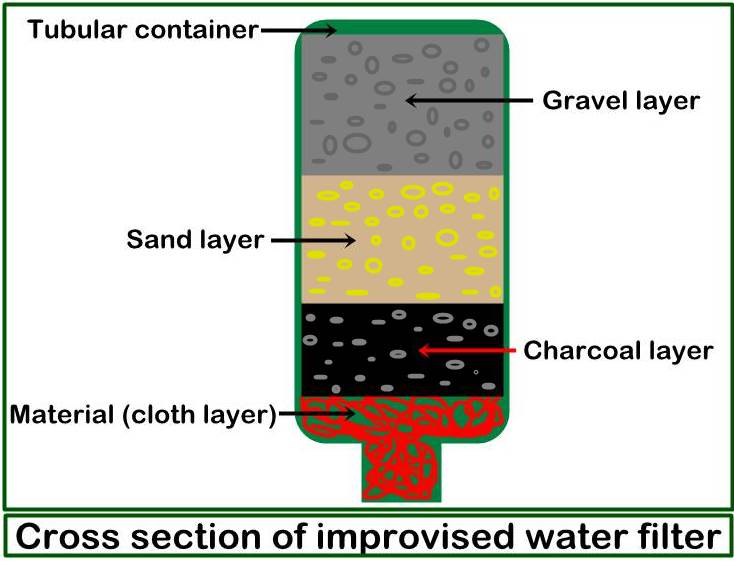
Improvised water filter for the field or home
Most experts will concur that the safest way to treat water is to boil it. Boiling water for a couple of minutes will ensure that all protozoa, viruses, bacteria and larvae are killed/denatured, rendering them harmless to human physiology.
However, boiling water will not remove particulate and chemical impurities such as grit, arsenic, pesticides, mercury, flouride, potassium. These can readily be found in many water sources, particularly if they are found near agricultural land or areas with high geo-thermal activity.
The safest way to make water potable is to filter it then boil it. Making an improvised water filter is a fairly simple process that ultimately could save your life. The simplest filter to build is pipe filter. This type of filter uses gravity to draw the water through several layers of media, each of which helps remove various types of pollutants.
To make this type of filter, you will need to make/find a tube. A 2 litre plastic bottle with the bottom cut off makes for a great container for this purpose. However, you could also use a drain pipe, a large stick of bamboo, a scaffolding pole or anything clean and tubular. Try and make sure that the tube is relatively clean to start with.
The tube should taper down towards the bottom as this will help prevent the various layers from falling out. The bottom layer can be made from a bunched up cotton cloth. This will hold the finer materials in place and provides a fine level of filtration. Dampen the cloth before inserting it as this will help achieve a tighter seal. If there is no cloth/material available, you can use grasses and weeds (make sure they are not poisonous!).
The next layer consists of charcoal. This can be gathered from you camp fire but should not be derived from poisonous woods such Yew. Use chunks and powdered charcoal. This is an important layer in this system as charcoal helps remove many impurities and actively traps pollutants such as chemicals.
The next layer should be made from fine, clean sand. Try gathering sand from shallow streams and rivers or their banks. This sand layer will stop the charcoal layer from moving about. The fine sand will also help trap finer particulate.
Finally, the top layer, made from small gravel and rocks helps trap larger particulate and also keeps the other layers from moving about.

Before using the filtered water, run a couple of litres through the system. When the water begins to run clear, the filter is ready for use. Discard the first cloudy batches of water. This is basically breaking in the system for use.
For extra safety, you can repeat the layering process more than once within the filter i.e. instead of four layers, you can have 8 or more.
If the filter is well made, it should remove nearly all particulate, giving you a clean looking glass of water at the end of the process. The charcoal layer should help to remove many chemical impurities. Hovever, to make the water safe to drink, it will need to be sterilised. Just because it looks clean, does not mean it is safe to drink. As stated above, the easiest way to do this is to simply boil the water. Failing a boil, one can also use chemical purification such as chlorine tablets, iodine, bleach, potassium permanganate. Please be sure you know what you are doing to avoid poisoning, particularly when using bleach, potassium permangenate and iodine, as these can all lead to fatal poisoning!!!
Combining a physical water filter with chemical or heat sterilisation should ensure your health. After several uses, the various layers will have to be replaced. The charcoal layer in particular will hold many impurities and should be changed regularly.
Stay safe!
The Bushgear Team

